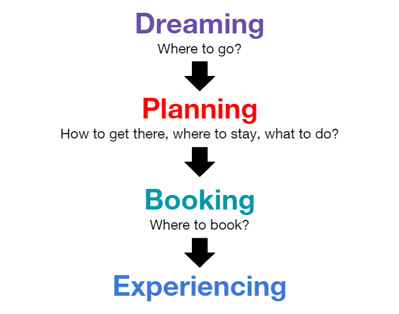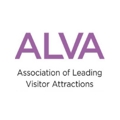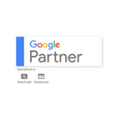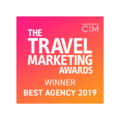Boosting more web visits for your visitor attraction

The way customers interact with travel brands online has fundamentally changed forever. In our recent whitepaper, An Industry Renewed, we explore how the pandemic has been a catalyst for digital transformation, with more people now researching and booking leisure and travel online.
To remain competitive, an attraction's website is more important than ever. Not only should it be fully accessible, functional, load quickly and be well designed, but it also needs to be found in the first place.
Fitting your attraction into the travel buying cycle
 Broadly speaking, the buying cycle for a visitor attraction starts at one of two points; either it acts as the initial inspiration for a trip, or it’s a later consideration when a traveller has picked their destination.
Broadly speaking, the buying cycle for a visitor attraction starts at one of two points; either it acts as the initial inspiration for a trip, or it’s a later consideration when a traveller has picked their destination.
Integrating these 'dreaming' and 'planning' stages into your digital strategy allows you to speak to audiences in the way they're expecting and respond to best.
Dreaming moments - Using social to grab people’s attention
In 2020, we saw attractions being incredibly creative on their social channels; behind the scenes tours, crowd-sourced exhibitions, and even penguins visiting their own aquarium. Lockdown demonstrated people connect to positive stories, and social media allows an attraction to interact with their audiences authentically and directly.
This organic social content is a great way of building a loyal and engaged audience, which generally drives visitors, however during key periods it's worth putting some budgets behind a paid social campaign, reaching audiences most likely to convert.
When our clients reopened last summer, we saw paid social advertising as the most effective channel for driving bookings, delivering over £2,000,000 worth of ticket sales.
Planning moments - beating out the competition
Once someone has decided on a destination, the next thing they generally do is begin planning an itinerary - and for many, this starts on a search engine.
Usually when you search for ‘things to do in {place name}’ the usual suspects come up:
- A blog from a publication like Time Out
- A subpage from a UK DMO
- A Google Travel display of ‘Top Sights’
- TripAdvisor
These sites have a good reputation with Google, and so trying to outrank them with your own itinerary style content will be difficult, which is why we advise spending your marketing efforts elsewhere, building direct relationships with highly engaged audiences.
Make friends with your local DMO, reach out to publications for key events you could partner with them on, and make sure your TripAdvisor profile is up-to-date and optimised, it will mean you don't have to spend time creating content that already exists, but you will also have the added benefit of being recommended via a reputable source.
This doesn’t mean you should avoid search marketing altogether, during peak season, it is also potentially worth bidding for the 'long tail keywords' as you will appear above organic articles and stand out when customers are looking for immediate answers.
Bid on your branded terms
As the official website for your attraction, you will benefit from appearing in the top spots when someone is searching for you directly. So it may seem counterintuitive to use marketing spend on your 'brand terms'. But there are multiple reasons why you would (and should) do this:
- It allows you to control your messaging and feature any particular offers outside of your organic listing
- It’s likely to be cheaper and will deliver a strong ROI.
- It stops your competitors from taking that spot from you.
Google Travel is becoming a one-stop-shop
In 2019, Google introduced Google Travel, their answer to giants such as TripAdvisor and Kayak, and designed it as a ‘one-stop shop’ trip planning and booking platform. Here are the products developed so far:
|
Google Explore |
Travel inspiration tool that shows holiday destination options based on budgets, interests and trip length. Once a destination is chosen then a customer is served information about when to visit, FAQs as well as links to other aspects of Google Travel. |
|
Google Things to Do |
An activities aggregator similar to TripAdvisor, showing experiences available in a destination, ranked based on the number of traveller visits and reviews. Currently, there are no booking or advertising options. |
|
Google Flights |
Flight aggregator similar to Skyscanner, with direct booking link options on the airline providers website. Google Flights have removed their advertising options, and instead rank results based on price and convenience |
|
Google Hotels |
A hotel aggregator similar to Kayak, with direct booking links to both OTAs and direct booking websites. There are multiple advertising options, both at the initial listings of hotels available and pricing options for individual hotels. |
|
Google Holiday Rentals |
Holiday rental properties share a lot of similarities with hotels on Google, including being fully integrated with Google Maps and Search results. The main difference is that they do not provide an exact address for privacy reasons. There are direct booking links to one of the many connected partners, but no advertising options currently. |
As a visitor attraction, Google Things to Do is the product to pay most attention to as it lets users know what's on offer within their chosen destination and makes recommendations based on user reviews. As an attraction owner, the services you can control are rather limited, but much like the rest of the Google Travel products, this will likely change in time.

Where I see this happening is around the ability for owners to be able to provide up-to-date information on upcoming exhibitions and events as well as providing booking links directly to their website.
Not only would it be incredibly useful for a traveller, but a lot of these features also are already available on the Google My Business Snippet for attractions, so it not being included feels like an oversight - one I predict will be fixed.
Only time will tell whether a paid advertising option will be introduced, with the direction Google Travel is going in, it seems unlikely. Instead, there will be an emphasis on organically rewarding attractions that have accurate information, as continuing to show sights based on the number of traveller visits and reviews they receive.
At Digital Visitor, we are experts in using digital channels to drive direct bookings for visitor attractions, including off-peak seasons. For more information, get in touch.
Jamie is Digital Visitor's Marketing Manager and oversees our messaging and content. If you are interested in knowing more about anything covered in this blog, or would like to see more on a certain topic please drop them an email.










